JUST HOW FAR FLUNG is the diaspora of Ethiopian cuisine? Well, how about some doro wot in Reykjavik, or a ye’tsom beyeyanetu in Brisbane?
You’ll find Ethiopian and Eritrean restaurants on five of the world’s seven continents. A few cities around the world have Ethiopian and Eritrean populations almost large enough to rival Washington, D.C., but there are, of course, no Ethiopian restaurants in Antarctica, and if there’s one in South America, it has no internet footprint, not even in Buenos Aires or São Paolo – clearly, a consequence of the Continental Drift.
My Ethiopian restaurant guide rounds up restaurants in the United States, and I have a page on this site that documents restaurant firsts around the world. But so far, I haven’t assembled a comprehensive guide to worldwide restaurants, and I doubt I ever will: It’s hard enough keeping up with U.S. offerings. Thus I offer this post as a sampling of the world’s Ethiopian and Eritrean restaurants for anyone who might be searching for them on the web. As always, I welcome additions, corrections and comments.
Canada. Almost all big cities and provincial capitals in Canada have Ethiopian restaurants, but the center of it all is Toronto, which has a community almost as large as the one in Washington, D.C. Surprisingly, though, the multi-cultural city of Montreal only has two restaurants.
Surely the country’s most unusual place is Zehabesha, located in Yellowknife, Northwest Territories, 62 degrees north latitude, population not quite 20,000. Apart from two places in Reykjevik, it’s the farthest-north Ethiopian restaurant in the world. The owners are Ethiopians who left Winnipeg and moved north seeking better opportunities. Their restaurant is, to be sure, a destination.
Compare that to Toronto, which has dozens of restaurants and markets – too many to name here. There’s a cluster along a stretch of Bloor Street West, a bigger cluster along Danforth Street, and numerous others sprinkled around the city. They all serve alcohol, but few of them serve t’ej, the Ethiopian honey wine. When I visited a few years ago, many of the restaurant owners didn’t even seem to know how to get it.
Some smaller cities within an hour or so of Toronto and around Ontario have restaurants, foremost among them Hamilton, home to Wass Ethiopian Restaurant. The owner, Wassie Mulugeta, is an entrepreneur and inventor who created the Wass electric grill, a 16-inch-diameter mitad sold in stores around the U.S. and Canada, and used by Ethiopians at home and in their restaurants to make injera. And not too far from Toronto and Hamilton, in the city of Guelph, there’s QB2 and Laza Catering. You’ll also find restaurants in the Ontario cities of Windsor (World Marathon and Addis) and Kitchener (A M Africa – Eritrean and the city’s first, opened in 1996).
In Montreal, you only have two choices for Ethiopian food: Le Nil Bleu, the city’s oldest, around for about 25 years now; and East Africa Restaurant, located along Rue Sherbrooke West in Notre-Dame-de-Grâce, a neighborhood with multi-cultural restaurants, an increasingly young professional population and a slightly bohemian feel.
Le Nil Bleu is an upscale place, with young waiters (non-Ethiopians) in black shirts and ties. The restaurant has a large Ethiopian menu joined by a newer selection of pan-African dishes.
East Africa Restaurant is much homier, a tiny place, longer than it is wide, with eight tables that seat a total of 16 people, plus a few more tables on a small outdoor patio. It’s owned by a married couple who themselves represent some of the diversity of Ethiopia: Maritu is Beta Israel – an Ethiopian Jew – and Abraham, who isn’t Jewish, was born in Asmara back when Eritrea was still a federated state of Ethiopia.
Canada’s smaller capital city, Ottawa, has a bigger Ethiopian presence in a few ways: five restaurants (none fancy), one that serves t’ej, and two markets that sell injera, spices and gesho. The city has had an Ethiopian restaurant since at least 1992. The five current ones are Habesha and Horn of Africa, a few block apart of Rideau Street; Blue Nile, a restaurant and market located in a residential neighborhood; the newest, Hareg Café; and Eri Café, the largest, an Eritrean restaurant, banquet hall and pool hall, short on decor but very roomy. (I visited Montreal and Ottawa a few years ago and wrote a longer piece about their restaurants.)
As you travel throughout Canada, visiting cities big and small, you’ll find Ethiopian restaurants sprinkled across the world’s second largest country.
Edmonton, Alberta, has a lot of offerings, most with websites, although some without any reviews on Yelp or other sites: Langano Skies, Abyssinia, Olympia Restaurant and Catering, Rendezvous, Blue Nile (always a popular name), Zembaba, Sunshine Habesha and Nigist (which doesn’t seem to have a website). Just a few hours away in Alberta, the city of Calgary has lots of options as well: Marathon, Fassil, Hdmona (Eritrean), Blue Nile and Ibex.
There are a lot in Vancouver, British Columbia, as well: Fassil, Axum, Harambe, Café D’Afrique, Gojo Café, Addis Café, Abyssinia and Lalibela. Not far away, in Victoria, British Columbia, there’s Blue Nile, an Eritrean restaurant opened in 2005, the first in the city.
In Winnipeg, Manitoba, there’s Kokeb, Massawa (Eritrean), Gohe and the homey Merkato, plus Blue Nile Restaurant and Hookah Lounge for the trendier set. And in Manitoba, the town of Brandon just got its first restaurant, Tana, in 2015.
Finally, Regina, Saskatchewan, has had Selam, a restaurant and hookah lounge, since 2003. Halifax, Nova Scotia, once had two, but now it seems to have none.

Jambo in Ludwigsburg, Germany (left), and Abyssinia in London, the city’s first and oldest.
Notice the very un-Ethiopian knives and forks in the latter.
Germany. There’s so much to say about Ethiopian food in Germany that I’ll say very little. You’ll find at least one Ethiopian restaurant in every major city: Bonn, Berlin, Stuttgart, Cologne, Hamburg (Karls, owned by an Eritrean man and a German woman, serves “Ethiopian-Eritrean specialties” along with brunch, sushi, wine and cheese), Heidelberg (an Eritrean restaurant, Blauer Nil, or Kilimanjaro), and the new East African restaurant Mandiba in Mainz.
Many of Germany’s smaller cities have restaurants, too: You can visit Savanne in Lich, Jambo in Ludwigsburg, Abessina in Kassel, Abessina in Göttingen, Mogogo (since 1988) and Abraham’s Cocktail Bar (since 2011) in Karlsruhe, Safari in Kaiserslauten, Okra and Lucy Abyssinia in Düsseldorf, Baobab (Eritrean) in Darmstadt, Shashamene and Abessinia in Nuremberg, Abessina in Nürtingen, Adulis (Eritrean) in Pforzheim, African Palace and Mesob in Wiesbaden, Africa in Tübingen, Mama of Africa in Gießen – and I’m sure I’m missing some!
But you’ll find the most – at least a dozen – in Frankfurt, a city with a large Ethiopian population. It’s also the home of Begena Tedj, a brand on honey wine made by an Ethiopian-born woman of European ancestry who now lives in Frankfurt and sells her t’ej around Europe and even in Canada.
Great Britain. You’ll find plenty of Ethiopian and Eritrean options in London, of course – around two dozen restaurants, enough to rival Washington, D.C. Some of them even make and bottle their own t’ej (or, at the Eritrean restaurants, mes, the Tigrinya name for the honey wine). Travel around the rest of England and you’ll find restaurants here and there: in Manchester (Habesha), Birmingham (Blue Nile) and Reading (Tutu’s Ethiopian Table). Selam Café opened in Liverpool in 2011 and closed a few years later. Ethio Cubano in Sheffield only lasted for a few years as well.
I can find no trace of restaurants in the United Kingdom’s outer boroughs – that is, Wales, Scotland and neighboring Ireland. Queen of Sheba opened in Glasgow in 2010 and closed a few years later. Dublin and Cardiff have African restaurants but no Ethiopian.
France. It will certainly come as no surprise that Paris is the heart of Ethiopian cuisine in France: The city has more than a dozen restaurants sprinkled around the city. But apart from that, don’t count on enjoying Ethiopian cuisine as you travel the French countryside: Toulon has Rastafari, Lyon has Messob – and that’s it for the whole country, as far as I can find. Seems that la cuisine française is hard to beat – at least in France.
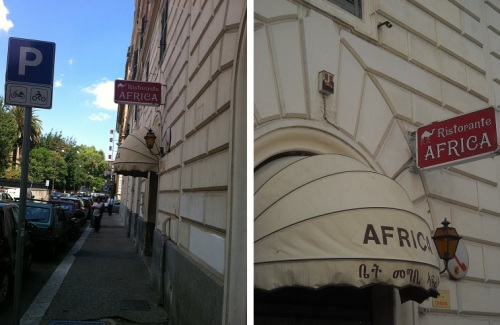
Ristorante Africa in Rome began life as an Eritrean restaurant and now bills itself as Ethiopian.
It may be the oldest Ethio-Eritrean restaurant in Europe.
Italy. For half a century, beginning in the 1890s, Italy colonized Eritrea, once the northern part of Ethiopia, but now an independent country. Italian cuisine took hold there during the colonial period, and not surprising, Eritrean cuisine found its way to Italy.
When it opened in 1972 – or perhaps even earlier – Africa billed itself as Eritrean (the cuisine is identical to Ethiopian). Today, the restaurant is “Etiopico-Eritreo,” citing both countries, because Ethiopian cuisine has become the brand. It’s the oldest Ethiopian restaurant in Europe, and possibly the first, although I have no doubt that many small Eritrean restaurants opened in Italy throughout the years and have left no easily traceable records.
As for today, Italy is another country where there are just too many Ethiopian and Eritrean restaurants to round up briefly. Rome alone has nearly a dozen, and you’ll find more in other large cities like Milan, Bologna and Naples, and smaller ones like San Leo and Riccione, which got their restaurants in the past few years. And more often than not, older restaurants in Italy are Eritrean: Bologna’s Ristorante Africano opened in 1990 and just celebrated its silver anniversary; and in Naples, there’s Mar Rosso, or Red Sea, again Eritrean.
The Rest of Continental Europe. From as far west as Madrid – there are no restaurants in Portugal – to as far east as Istanbul (there’s Habesha, located above the nightclub She-Va), Ethiopian and Eritrean restaurants pop up all across the rest of Europe.
Greece seems to have only two restaurants: Lalibela and Axum (a nightclub as well), both in Athens. But I came across a few paragraphs in a book that seem to indicate Greece might have had Ethiopian restaurants as early as the 1970s thanks to emigrants from Africa. So there may be more out there now that I just can’t find listed online.
In Spain, Madrid has at least three (Habesha, Nuria and Hanan), and Barcelona has the recently opened Addis Abeba. Lalibela in Budapest began as a catering service in 1996 and is now a full-service restaurant with both Ethiopian and Hungarian cuisine. Abyssinia in Warsaw also began as a catering company, in 2013, and became a restaurant two years later. Heiderscheid (in Luxembourg) has the unusually named Jimmy. Alas, poor Prague recently lost its sole Ethiopian restaurant.
Three other countries on the continent have numerous restaurants spread across several cities. You’ll find most of Belgium’s restaurants in Brussels, with a few in Antwerp. Amsterdam is another big Ethiopian and Eritrean restaurant town, with about a dozen places, plus others in Leiden and (since 1992) Eindhoven, Netherlands. And hooray for Rotterdam, which has Viva Afrika and Gojo.
Finally, here’s Switzerland, which has chosen not to stay neutral. Geneva has half a dozen restaurants (including La Gazelle d’Or – the Golden Gazelle – which is Eritrean, and which also serves pizza), Zürich has at least two, Lausanne has had Abyssinia (its first) since 2005, and Bern got Injera in 2011

Dinner at Gådjå in Oslo and Abyssinia in Stockholm. The former includes some spicy Ethiopian condiments.
The Nordic Countries. The world’s five Nordic (sometimes called Scandinavian) countries – Denmark, Sweden, Norway, Finland, Iceland – all have Ethiopian restaurants, although not a lot of them, and for the most part, only in big cities. In general, the farther north you go, the less likely you are to find one, and Reykjavík, the Icelandic capital, host the world’s two farthest-north Ethiopian restaurants.
I’ve been able to track down at least four Ethiopian restaurants in Sweden, all scattered about Stockholm, the capital. The oldest, and the city’s first, is Abyssinia, opened in 2002. The others are Ethiostar, Jebena (Eritrean) and Gojo. From the looks of them, all are rather upscale in their decor compared to so many of the tiny mom ‘n’ pop places you find across the United States.
In Norway, you have several options. Oslo’s two restaurants are Lalibela and Saba, located a few blocks from each other. The city’s first Ethiopian restaurant, Exodus, opened and closed long ago, in the early 1990s.
Stavanger, almost 300 miles west of Oslo, has Gådjå Etiopisk Restaurant – in English, that’s gojo, an Ethiopian thatch-roofed hut – and in Bergen, about the same distance northwest of the capital, there’s Selam, which bills itself as Ethiopian and Eritrean – which certainly means that the owner is the latter. Both get high praise in online reviews, and one patron said the food at Gådjå “tastes better than the country of origin” (this presume he’s been to Ethiopia, of course).
Denmark’s first Ethiopian restaurant, Mesob, opened in Copenhagen in 1999 and no longer exists. But two others now take its place: Ma’ed, which has a menu written in English, and Lalibela, whose website offers its menu in English and Danish versions. The restaurants are about a mile apart, on opposite sides of Hans Tavsens Park in the northern part of the city.
You’ll find two Ethiopian restaurants in Iceland: The first to open, in 2011, was Minilik, in the city of Flúðir, about 60 miles from Reykjavik, which got its own restaurant, Teni, in 2014. Minilik did so well that its owners opened another place with the same name in the town of Kópavogur, which is more or less a suburb of Reykjavik.
These places are the northernmost Ethiopian restaurants in the world right now at about 64.133 degrees north latitude. But they’re not the record holder: For a few months in 2007, Tekul served Ethiopian food to some lucky patrons in Fairbanks, Alaska – at 64.843 north latitude.
Finally, there’s Finland, the Nordic country that doesn’t speak a Nordic language (except for those Finns who speak Swedish). Helsinki seems to have only one restaurant, Kuningatar Saba, which translates as Queen Sheba, the name you’ll find on the restaurant’s Facebook page.
The menus of most of the Nordic restaurants are in their native languages, although the names of the dishes appears to be Amharic transliterated into English, most likely because the pronunciation of words like misir wot are close to how they sound in English. Only a few words change: In Finland, for example, the mildly spiced stew alicha is written alitsa, along with the familiar English name (there’s no letter in Finnish to represent the “ch” sound), and “ye” (the Amharic preposition “of”) becomes “je.” This change also happens in Swedish, although those menus use alicha.
The Middle East. In the late 1980s and early 1990s, the Israeli government airlifted tens of thousands of Ethiopian Jews – who call themselves Beta Israel – out of Africa, resettling them in Israel. After a while, they began to open restaurants, and there are many in Tel Aviv and Jerusalem, along with numerous tiny subsistence Eritrean restaurants, especially in the Neve Shaanan neighborhood, opened by immigrants from that struggling country.
The restaurants owned by Ethiopian Jews are usually kosher, and most don’t have websites, although a few of them do, all in Tel Aviv: Balinjera, Tenat, Habash and Tewodros (named for an 18th Century Ethiopian emperor who met a rather ignominious end).
Cairo got its first restaurant about 10 years ago. It’s gone now, but in its place is Samar al-Nil and the catering service Haleluya’s, which prepares meals for parties of five or more. Amman, the Jordanian capital, has Abyssinia. And the Lebanese capital, Beirut, doesn’t seem to have an Ethiopian restaurant, but there is Mótto, which hosts chefs of different cultures and cuisines, changing every few days, and including Ethiopian from time to time. The restaurant also has a policy of allowing you to pay what you think is fair.
Ethiopian food seems to be very popular in the United Arab Emirates, where I find at least 10 restaurants in Dubai alone. The oldest is Al Habesha, opened in 2000, and later joined by Abesinian, Messob, Zagol, Milen, Dukem, Yeshi Kawa, Jimma and Qasr al Salam. Some of these serve Middle Eastern and European cuisine along with their full Ethiopian menus. Al Habesha also has a second location in Abu Dhabi, UAR, where you’ll also find Bonna Annee. The Habesha chain (if you can call it that) runs ads on TV to promote itself. Nearby Bahrain once had Millennium, an Ethiopian restaurant located in the Concorde Hotel in the city of Manama, but it seems to be somewhat recently gone.
Saudi Arabia has a sizable Ethiopian population made up of Ethiopians brought into the country as laborers and housekeepers. There seems to be at least one restaurant, Abyssinia, in the coastal town of Jeddah, not far from Mecca.
Ethiopian restaurants come and go in Sana’a, the capital of Yemen, which has had them for a decade or more thanks to its many Ethiopian laborers. I can find no website for one now, so clearly, they exist way off the radar. One such place may be “Merkato Ethiopian Food, across from Al-Hudda grocery,” according to a few websites. Let me know if you find it. I also see mentions of Al-Zajni, Al-Tabs and Al-Ktfoo restaurants in a 2012 newspaper article. Those names seem like ways of rendering zigni (a beef dish), tibs (another beef dish) and kitfo (a raw meat dish).
Africa. Not far from Ethiopia, in the neighboring African countries or Djibouti, Tanzania, Kenya and Uganda, you’ll find a good number of restaurants – too many to list them all (and others surely off the map). And there are many more in numerous other African countries.
You could have a meal at La Terrasse, Saba or Kokeb Star (or, in French, L’Étoile Kokeb), three Ethiopian restaurants in Djibouti, or you could just take a nice stroll across the border and eat in Ethiopia. You can also get a meal at the restaurant of the Ethiopian Community Association in Djibouti – the place is called Club Ethiopien. With Ethiopia, Eritrea and Somalia bordering the tiny country, there are no doubt others, although my searches turn up no Eritrean restaurants.
Just south of Ethiopia, it’s no surprise that Kenya has quite a few restaurants, especially in Nairobi: There’s Smart Village (Eritrean), Asmara (also Eritrean, with pizza on the menu), Blue Nile, Sabrina’s, Habesha Gigiri, Abyssinia, Daas and Ethiopian Restaurant. There’s also a Habesha in Kisumu, Kenya, about 200 miles northwest of Nairobi, and known for its tranquil garden setting.
Just a step to the west, you’ll find Uganda, which has many restaurants “sprinkled across the suburbs” of Kampala, the capital city, according to The Monitor, a Ugandan newspaper. Ethiopian Village opened in Kampala in 1992, and it’s still there. The city also hosts Gojo, Fasika, Dukem, and the deceptively named Casablanca. I also find at least one Eritrean restaurant, Chuchu, located on Rugaba Road. About 30 miles south of Kampala, along Airport Road in Entebbe, you can get an Ethiopian meal at Abyssinia Cottage or at Betty Ethiopian Restaurant and Inn.
Heading south from there, Tanzania has plenty as well. Since 1998, Addis in Dar has thrived in the nation’s former capital and largest city, Dar es Salaam. You’ll also find Arada and Rohobot. In Zanzibar City, there’s Abyssinian Maritim. In Arusha, you’ll find Spices & Herbs, the city’s first, opened in 1999, and it’s a bed and breakfast lodge as well. The city now also hosts the newer Abyssinia.
Across Africa, big cities in big countries all have Ethiopian restaurants. Somehow I doubt that Abuja, the capital of Nigeria, Africa’s largest country, only got its first Ethiopian restaurant in 2013. But Saba, located in the city’s Maitama Amusement Park, is the first and only one that I could find, and Metropole magazine claims its the city’s first. I can find no hint of any other Ethiopian restaurants in Nigeria, not even in Lagos. Perhaps the nation, which has its own unique cuisine, prefers to dine at home (so to speak).
Nearby Ghana has fared better – or at least, it’s left more of a paper trail. The capital city of Accra got its first restaurant in 1994 (long closed) and now has Ethiopian Restaurant and Bar, which offers a buffet, as well as the elegant and upscale Simret.
South Africa has Ethiopian restaurants in all of its biggest cities. Johannesburg boasts the most, and the city even has a cluster of businesses on Jeppe Street informally known as Little Ethiopia or Little Addis (after the Ethiopian capital). There’s Queen Sheba, Little Addis Café, Blue Nile, Abyssinia, Netsi’s, and the regal-sounding James XVI Ethiopian Café (owned by James Wondeson), where you can dine outdoors under a shade tree.
Cape Town has a few restaurants, including the popular Addis in Cape, along with Little Ethiopia. In Durban, you can dine at Café Abyssinia and Habesha. The city of Port Elizabeth offers two options: Messer’s (named for its proprietress) or Ethiopian Restaurant. And in Pretoria, Queen of Sheba offers Ethiopian food and a spice shop.
Kigali, Rwanda, has had Ethiopian restaurants since at least 1997, and now the city seems to have just one: Lalibela, with a good lunch buffet (online reviews claim). In Dakar, the capital of Senegal, there’s also a Lalibela (no relation), opened in 2006, with new ownership since 2015, and now it’s joined by Addis Abeba.
In the newly formed nation of South Sudan, you’ll find Queen of Sheba in Juba, the capital city, although it tends to be frequented more by foreigners. It’s right next door to the Keren Hotel. Meanwhile, to the north, the Sudanese capital of Khartoum has a few traceable places – African Village (not far from the university), Habesha, and the just plain Ethiopian Restaurant – as well as many tiny places that I’m sure don’t show up on the internet.
Monrovia, the Liberian capital, has Bishoftu, named for a town in Ethiopia (no doubt the owner’s homework), and whereas an online reviewer call it “one of the better Ethiopian restaurants in town,” I can’t find any others. Wednesdays and Saturdays are buffet nights. The city’s Kaldi’s Koffee, although named for the Ethiopian goat herder who discovered the beverage, doesn’t serve the cuisine (but it does serve bagels).
Bouncing around Africa, we find more restaurants. In Lilongwe, the capital of Malawi, there’s Queen of Sheba, and in the southern city of Blantyre, there’s Alem. In the Angolan capital city of Luanda, Habesha restaurant near the U.S. embassy serves generous portions of Ethiopian food. If you visit Lusaka, Zambia, have a meal at Green Ethiopian Restaurant, which is also a disco and bar, or at the restaurant in Lusaka’s Melsim Lodge, which serves Ethio-Eritrean-East African cuisine. You’ll also find Ethiopian food at Abyssinia in Gaborone, Botswana. Ouagadougou, the capital of Burkina Faso, has two restaurants, both with French names: Chez Haregua and Restaurant Ethiopien.
In troubled Zimbabwe, Queen Makeda serves Ethiopian food in Harare. Just be on the lookout for Mengistu Haile Mariam, the former Ethiopian dictator, who fled to Zimbabwe in 1991 and has since been tried in absentia and found guilty of crimes against the nation.
Bamako, Mali, once had Abissinia (now closed), and N’Djamena, the capital of Chad, seems to have a restaurant called Dessie, although I can’t find anything to confirm that. Nor can I find much about Abyssinia in Windhoek, Namibia.
Australia & New Zealand. Let’s start with some of the more isolated South Pacific destinations for Ethiopian food.
In the Australian community of Mount Isa, population around 22,000, you can have Ethiopian or Australian cuisine at Abyssinia, opened in 1994 thanks to Almaz Taye, an Ethiopian woman who married an Australian mining engineer. They moved to this village, and Almaz opened her restaurant in the touristy Townview Motel.
You’d probably expect to have a devil of a time finding an Ethiopian restaurant in the Australian island state of Tasmania. And yet, there’s Axum, opened in 2008 – although I can’t tell if it’s still in business (and don’t want to call to find out). Meanwhile, on the other nearby island, New Zealand has one restaurant, recently opened: Café Abyssinia arrived in Auckland in 2012. Wellington welcomed The Meeting Tree in 2014 – and said goodbye to it by 2016.
On the big island, many of Australia’s larger cities have Ethiopian restaurants. You’ll find about 10 in Melbourne and environs, and a trio in Adelaide and in Sydney (Jambo Jambo, Aaboll Café, A Taste of Ethiopia). There’s also a couple in Canberra (Ethiopia Down Under opened in 2002), a pair in Perth (Ethiopian Cafe & Artifacts for food and gifts, or Echye’s for just food), Mu’ooz (Eritrean) in Brisbane, Made in Africa in nearby Moorooka, Habesha in Newcastle (since 2014), and Café Merkama in Ballarat (also 2014).
Asia. The world’s biggest continent has the world’s fewest number of Ethiopian restaurants (apart from the two continents that have none): You’ll find two in Japan, two in Russia, and one in each of a few other big Asian cities, from Thailand to the Philippines.
Russia has had an Ethiopian restaurant since 1999: Addis Ababa, located along the Garden Ring in central Moscow, and for many years called Bungalow Bar. It serves traditional dishes, like tibs and t’ej, and some very untraditional (and expensive) ones, like alligator, ostrich, kangaroo – and “Mexican pork.” Bungalow got come competition in 2013 with the arrival of Addis Abebe, which has a website (unlike Bungalow) and a menu with the dishes and their descriptions written in both English and Russian.
Even the Ukraine, Russia’s beleaguered neighbor, now has a restaurant that serves Ethiopian food: In Kiev, you can get the food of several cultures at the eclectic Sarman, which also serves dishes from Azerbaijan, Georgia (the country), Europe, Russia, Ukraine and some other African countries.
China got its first Ethiopian restaurant in 2007 when Ras opened in Beijing. The owners, an Ethiopian-American and his wife who moved their family from the Washington, D.C., area to China, first opened in the city’s far-out Lido neighborhood then moved to Sanlitun a year later and opened a covered outdoor bar to accompany the elegant restaurant. Ras’ name in Chinese, 家埃赛俄比亚餐厅, translates as “Family Ethiopian Meal House” (or “dining room,” depending upon the translator).
The only other Ethiopian restaurant you’ll find in China is Eat Ethio, a pop-up restaurant that serves from time to time in Shanghai and Hong Kong. You have to be alert to find them. Co-owner Helina Tesega, an Ethiopia native, has lived and worked in China for several years.
There aren’t a lot of options in Tokyo. Queen Sheba opened in 1990, making it the oldest place in Asia, and it’s still popular, even serving Ethiopian beer, along with a few African, Middle Eastern and fusion dishes (like smoked duck with mustard sauce, or fried octopus with potatoes). The city also has a Blue Nile, but Axum recently closed.
I could track down only one more Ethiopian restaurant in Japan: Fasika in Fukuoka, opened in 2008 and closed a few years later. Safari, an African restaurant in Tokyo, has doro wot on its menu but no injera, and most of its other dishes are more west African.
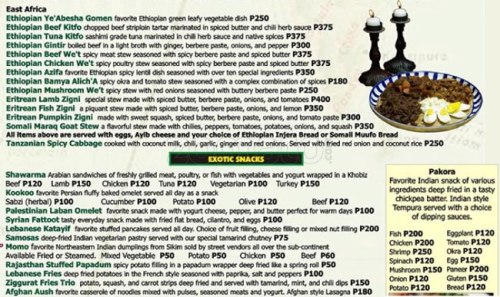
Here’s the Ethiopian portion of the huge multi-ethnic menu at Ziggurat in Manila (click to enlarge)
Bangkok’s Abyssinia Café opened in 2003 and closed a few years later. But now there’s Habesha, the only Ethiopian restaurant in Thailand. Both owners are originally from Ethiopia, although one lived in Virginia before moving to Thailand. The handsome restaurant seats about 30 people around seven tables.
Ethiopians have told me that when they can’t find an Ethiopian restaurant in an American city, they enjoy Indian cuisine because it uses many of the same spices as Ethiopian cooking. And yet, I can find only one Ethiopian restaurant in India: Blue Nile serves at the Ethiopian Cultural Center in New Delhi. It offers a full menu of meat and vegetarian dishes, along with Indian and continental meals.
Finally, in Manila, you can find Ethiopian food at Ziggurat, which has an appropriate name – it’s an ancient tower that probably inspired the tale of the Tower of Babel – and a menu that would make a United Nation’s delegation happy. The East African portion of the menu is mostly Ethiopian and Eritrean, with Somali and Tanzanian dishes thrown in – as if they could possibly compete.
University of Pittsburgh
Here’s a commercial, in Amharic, for Al Habesha restaurant in Dubai.
The customers dance at Abyssinia Café in Paris.
An American pays a visit to Smart Village Ethiopian restaurant in Nairobi, Kenya.
Watch an Ethiopian coffee ceremony at Minilik in Reykjavík, Iceland.
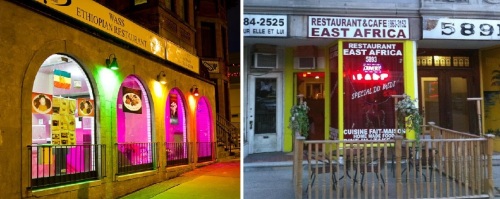


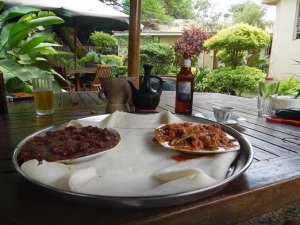


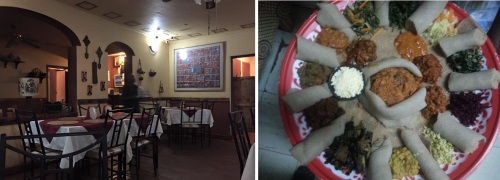
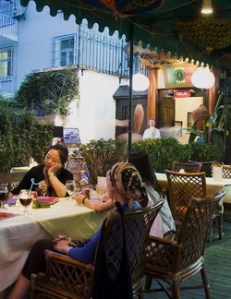


Leave a comment